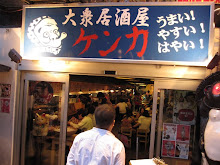The Frida Kahlo Exhibit
>> Saturday, April 26, 2008
The Frida Kahlo exhibit has been in town since the end of February and since her work is so famous and iconic, I wanted to go see it. I've been telling Medic Guy for the longest time but he never have time during the day to go with me. I found out that the museum actually stays open on Friday night until 8:45pm, so I told him that we should go on Friday and I'll even ditch work early so we would have more time. Coincidentally, some of my friends from the Afro-Asian Mahjong Brigade were thinking about doing that, have dim sum and go see Alvin Ailey's dance performance on Saturday. So it was a win-win.
Thursday night came, Medic Guy was nowhere to be found. I gave him an email to ask him what's going on and he didn't respond until 2:00pm on Friday, saying he won't be able to make it, and my other friends told me that not a lot of people are interested in seeing Frida. So I got a bit pissed and went by myself. Just as well.
Frida Kahlo was born in Mexico in 1907. When she was 18, she got into an accident which left her with a broken collarbone, broken spinal column, broken ribs, broken pelvis, fractured legs and feet, dislocated shoulder and a punctured womb. She nearly died from the accident, that and her stormy marriage with Diego Rivera left her in physcial and emotional pain for the rest of her life. Most of Frida's work describes such pain.
Animals are symbols of children that Frida can never have
Frida is well known for her self-portraits. There's a certain iconic look to it, especially with her strong, spirited unibrow. She utlizes Mexican mythology and heavy symbolism and surrealism in her work to illustrate death, pain, politics and infertility. But other than the iconic self-portraits that confronts her audience with her pain head-on, her most powerful work in my opinion has to do with the story telling of others.
One piece entitled "Unos Cuantos Piquetitos" (A Few Small Nips) is about an incident in Mexico where a jealous husband stabbed her wife to death and the husband's response to the jury was "It was just a few small nips." As if it was the wife's fault for dying so easily. Frida painted the picture as a protest for gender inequality in Mexico. Red paints flowed from the corspe of the woman's body and tainted around the frame.
Unos Cuantos Piquetitos
"El Difuntito Dimas" (The Deceased Dimas) is a portrait of a friend's dying son. Despite Frida's effort to persuade the child's parent to get the child to see a western doctor, the child was not cared for medically and ultimately died. Frida painted the kid staring out of picture lifelessly wearing a paper crown and a golden robe surrounded by marygold laying on a weave mat as if a king. It illustrated the Mexican culture and its natural reaction to death.
Actress Dorothy Hale committed suicide after the death of her husband, her friend Clare Boothe Luce commissioned Frida to do a painting to memorialized her. But instead of a portrait, Frida did a storytelling ex-voto style painting which illustrated her suicide. "El Suicido de Dorothy Hale" retold the story of Dorothy Hale jumping from a tall building into the ground, serene and yet bloody at the same time. Luce horrified, wanted to destroy the painting and refused to pay.
El Suicido de Dorothy Hale
Frida died at age 47, one of her last diary entries read "I hope the exit is joyful - and I hope never to return - Frida". Life must have been unkind.
As I walked out of the museum, I felt a sense of loneliness. Here I am, gazing down the beautiful Ben Franklin Parkway, another great experience all to myself. I texted Principe in Argentina telling him that I really misses him and he texted me back with the same affection as always. I fought back my tears and walked the long way home.






